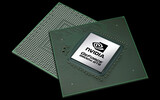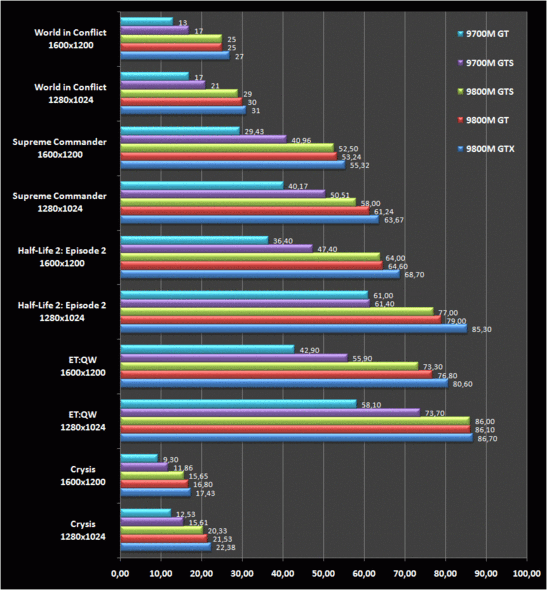NVIDIA GeForce 9800M GTS

The Nvidia GeForce 9800M GTS is a graphics adapter for laptops and is based on the G94 core with 64 shader processors. The chip is produced in 65nm (512 MB) and later in 55nm (1024 MB versions). Therefore, the power consumption between both boards are similar at about 75 watts each. Note that the 55nm version of the 9800M GTS was later renamed to the GeForce GTS 160M.
Because of the additional shaders and higher clock speeds, the 9800M GTS is noticeably faster than the 9700M GTS (see benchmarks below). Therefore, DirectX 10 games of 2008 should all be playable in medium to high detail settings.
As with all DirectX 10 cards, the GeForce 9800M GTS renders 3D images using "Unified Shaders". Dedicated pixel- and vertex shaders are completely replaced with 64 so called Stream Processors, which now take over most of the graphics workload. Furthermore, these shader units are clocked higher than the core GPU itself.
An advantage of the GeForce 9000 series is the integrated PureVideo HD video processor. The GPU is able to assist the CPU in the decoding of H.264-, VC-1-, MPEG2- and WMV9 video formats throughout a wide range of resolutions.
In conjunction with the Nvidia 9100M G integrated graphics, the 9800M GTS supports Hybrid-SLI (only HybridPower). HybridPower is a Windows Vista-only technique for switching between integrated and discrete graphics for power-saving purposes. The technology was eventually supplanted by a more automatic and optimized system, called Optimus. GeForceBoost is not supported with this card as there would be no performance gain from combining the discrete 9800M GTS with the integrated GPU.
Compared to desktop graphics cards, the 9800M GTS should be a bit slower than the GeForce 8800 GS, the latter of which has a higher memory clock rate.
GeForce 9800M Series
| |||||||||||||||||||
| Codename | NB9E-GT | ||||||||||||||||||
| Architecture | G9x | ||||||||||||||||||
| Pipelines | 64 - unified | ||||||||||||||||||
| Core Speed | 600 MHz | ||||||||||||||||||
| Shader Speed | 1500 MHz | ||||||||||||||||||
| Memory Speed | 800 MHz | ||||||||||||||||||
| Memory Bus Width | 256 Bit | ||||||||||||||||||
| Memory Type | GDDR3 | ||||||||||||||||||
| Max. Amount of Memory | 1024 MB | ||||||||||||||||||
| Shared Memory | no | ||||||||||||||||||
| API | DirectX 10, Shader 4.0 | ||||||||||||||||||
| Power Consumption | 75 Watt | ||||||||||||||||||
| Transistor Count | 504 Million | ||||||||||||||||||
| technology | 65 nm | ||||||||||||||||||
| Features | PureVideo HD, HybridPower, | ||||||||||||||||||
| Notebook Size | large | ||||||||||||||||||
| Date of Announcement | 15.07.2008 | ||||||||||||||||||
| Information | MXM 3 | ||||||||||||||||||
| Link to Manufacturer Page | www.nvidia.com | ||||||||||||||||||
Benchmarks
3DM Vant. Perf. total +
* Smaller numbers mean a higher performance
Game Benchmarks
The following benchmarks stem from our benchmarks of review laptops. The performance depends on the used graphics memory, clock rate, processor, system settings, drivers, and operating systems. So the results don't have to be representative for all laptops with this GPU. For detailed information on the benchmark results, click on the fps number.
| low | med. | high | ultra | QHD | 4K | |
|---|---|---|---|---|---|---|
| Crysis - GPU Benchmark | 92 | 52 | 33 | |||
| low | med. | high | ultra | QHD | 4K | < 30 fps < 60 fps < 120 fps ≥ 120 fps | 1 | 1 | 1 | | | |
For more games that might be playable and a list of all games and graphics cards visit our Gaming List
Gaming Performance
These benchmarks were conducted with high end notebooks (quad-core desktop CPU). Therefore, the performance with slower laptops may decrease.
Crysis: 1280x1024, very high: 21 fps -> not playable (in high playable)
Enemy Territory: Quake Wars: 1600x1200: 76 fps -> fluently playable
Half Life 2 - Episode 2: 1600x1200: 64 fps -> fluently playable
Supreme Commander: 1600x1200: 53 fps -> fluently playable
World in Conflict: 1280x1024: 30 fps -> playable
Notebook reviews with NVIDIA GeForce 9800M GTS graphics card
Gateway P-7808u: Intel Core 2 Quad Q9000, 17.00", 4.1 kg
External Review » Gateway P-7808u
Gateway FX P-7805u: Intel Core 2 Duo P8400, 17.00", 4.1 kg
External Review » Gateway FX P-7805u
Toshiba Qosmio X305-Q708: Intel Core 2 Extreme QX9300, 17.00", 4.5 kg
External Review » Toshiba Qosmio X305-Q708
Gateway P-7805u: Intel Core 2 Duo P8400, 17.00", 4.4 kg
External Review » Gateway P-7805u
Packard Bell iPower GX-M-002GE : Intel Core 2 Duo T9400, 17.00", 4.2 kg
External Review » Packard Bell iPower GX-M-002GE
Gateway P-7801u : Intel Core 2 Duo P8400, 17.00", 3.8 kg
External Review » Gateway P-7801u
Gateway P-7811FX : Intel Core 2 Duo P8400, 17.00", 4.2 kg
External Review » Gateway P-7811FX





